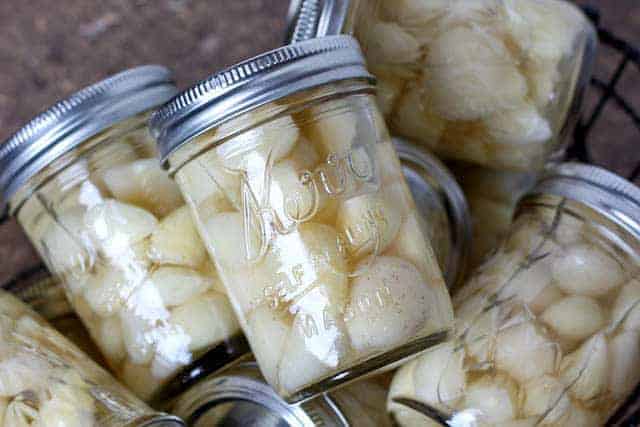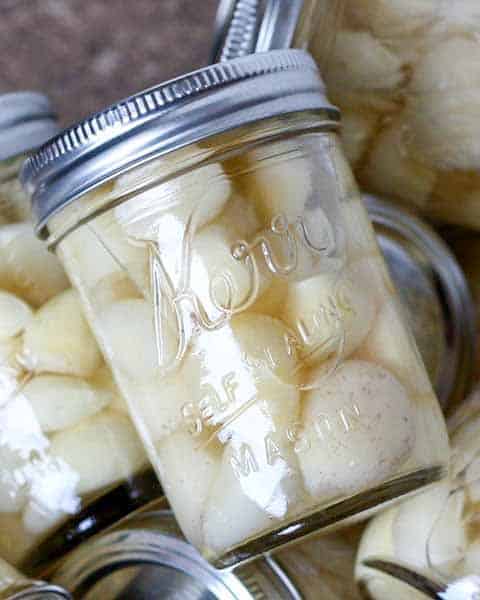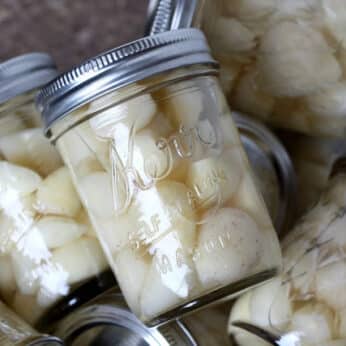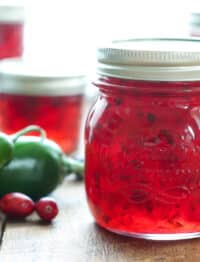Preserving garlic, also called pickling garlic, is one of the easiest ways to save your garlic harvest. There’s nothing better than having fresh garlic ready to use all year long.
About ten years ago, I found myself with a huge harvest of hard neck garlic and no possible way to use it all before it began sprouting. I love garlic and cooking with garlic but even so, I knew I needed to figure out how to preserve garlic.
While I’ve canned fruits and vegetables before, I’d never thought to try preserving garlic. My brother Miles visited us last week and was kind enough to spend a couple of hours showing me how to can it.

As it turns out, it is almost ridiculously simple. It’s so simple and so effective that I wish I had learned to do it a long time ago.
We all love having garlic ready to use now in the refrigerator and I’m excited to share my findings with you!
This garlic tastes FRESH. If you’ve ever bought a jar of minced garlic or peeled cloves in oil or vinegar, this doesn’t resemble any of those things. I have used the preserved cloves in a couple of recipes already and the taste is exactly the same as fresh.
How to Preserve Garlic
Raw, dried garlic can be kept for months in a cool and dark environment. However, here in the very warm southwest, it rarely lasts over a month in my home before it sprouts. Preserving it with this easy pickling method helps keep it fresh for months.
Wondering if this method yields garlic with a pickled, vinegary taste? It doesn’t. The natural oils of the garlic prevent the vinegar from being absorbed into the cloves! Handy, right?
To use your preserved garlic, just take out the number of cloves you need, rinse quickly with water, and use as desired. If you want a slight vinegar bite to the garlic, or if you are using it in a recipe that also calls for vinegar, simply use the garlic without rinsing.
Also called pickling garlic, this method is one of the most common ways to save your garlic harvest. At any given time, you’re likely to find a row of jarred garlic tucked in the back of my refrigerator.
Why Does Garlic Turn Blue
Updated 9/19/12 to answer multiple questions regarding, Why Did My Garlic Turn Blue? If your garlic does turn blue, it is still safe to eat.
This can happen when enzymes and amino acids present in garlic react with the sulfur compounds responsible for garlic’s pungent smell. I’ve seen this happen a few times over the years and apparently, it is fairly common.
Selecting Garlic
If you don’t grow and harvest your own garlic in a home garden, follow these tips for selecting the best and freshest heads of garlic from your farmer’s market or grocery store to use in your preserved garlic recipe:
First, look for heads of garlic without sprouting. Sprouting is an immediate indicator that the garlic is no longer fresh and not worth your money.
Next, give the garlic a quick “sniff and squeeze.” If it smells mildewy or moldy, give it a pass. That’s an almost sure indicator that the garlic has gone rotten.
Fresh garlic cloves should never be soft or squishy. A fresh head of garlic will be firm to the touch and not yield with a light squeeze.
How to Peel Garlic
Arguably the most time-consuming part of the process of preserving garlic is peeling it. Of course, you can just use your fingers and peel away but if you’re looking for a faster process, or run into a stubborn clove whose skin just won’t peel, here are a few popular tricks.
I’ve tried all of these methods and it really just depends on how much garlic you need to peel, how you plan to use it, or if you’re preserving it.
The method below requires just Two Metal Mixing Bowls and it is my favorite.
- Take your whole head of garlic and place it in a large metal bowl.
- Place another bowl the same size on top of the first bowl so that you have an orb shape.
- Shake the two bowls very hard for about 30 seconds.
Keep in mind that this method works best with older garlic where the skin is already a little loose. Vigorously shaking the garlic in the bowls allows the skins to just break and fall away from the cloves. This method works best when using large quantities of garlic to smash into each other and help the process along.

Likely the most well-known method of peeling garlic cloves in a flash is by hitting the clove with the flat side of the knife. This is handy when cooking, but for this recipe, we want to preserve whole cloves intact so be careful not to smash your garlic if you try this method.
Similar to the bowl method above, you can also place the garlic cloves in a glass jar with a closed lid and then vigorously shake to loosen the garlic skin. This is definitely effective but, the amount of garlic you’re able to process this way is limited.
You can also use the microwave or warm water to heat the garlic slightly, making it easier to peel with your fingers.
Preparing Garlic
Depending on when your garlic was harvested you might notice some brown spots on the cloves. This is perfectly normal and doesn’t mean your garlic is rotten.
After rinsing once, I used a small paring knife to trim off brown spots on my garlic cloves. After all the brown spots are removed, rinse the garlic bulbs a second time and proceed with the recipe as directed.
Storing Garlic
If you use the method outlined in the recipe, you’ll need to store your jars of preserved garlic in the refrigerator to make them last. Designate one side of a shelf or a shelf on the inside of a drawer for your garlic jars. They should stay fresh for several months and even up to a year.
Sticking with this basic refrigerator canning method is by far the easiest and more reliable way to preserve garlic.
While there are multiple sources online that claim pressure canning works, I’ve removed this information, based on a reader review that doing this destroyed her garlic. I stick with my recommendation of preserving garlic in vinegar in the refrigerator. According to the USDA, “Canning of garlic is not recommended. Garlic is a low-acid vegetable that requires a pressure canner to be properly processed. Garlic loses most of its flavor when heated in this way. For this reason, adequate processing times have not been determined for canning garlic.”

How to Use Preserved Garlic
Now that you know how to preserve garlic, you can use that garlic anywhere you’d use the fresh stuff. And believe me when I tell you it maintains all the same aromatic, flavorful goodness of a freshly harvested garlic bulb.
Sauteed garlic is a must-have for countless savory recipes. We use it in everything from Garlicky Ginger Stir-Fry for a quick and easy weeknight meal to Sauteed Zucchini Ribbons.
Preserved garlic (rinsed and patted dry) is also amazing roasted! Use it in Roasted Garlic Quinoa with Mushrooms, Roasted Garlic and Bacon Guacamole and Roasted Garlic White Bean Dip and be everyone’s new best friend.
I also love garlic as an ingredient in salad dressing, sauces, marinades and savory spreads. It’s just divine in Beer and Garlic Marinade, Mojo Marinade, and in Homemade Ranch Dressing. This Chipotle Garlic Sauce served with roasted fingerling potatoes are a garlic lovers’ dream.
True garlic fanatics NEED to try the Garlic Lover’s Potato Salad. That recipe alone is worth “putting up” a big batch of garlic so you have it on hand anytime a craving strikes.
Give preserving your own garlic a try. I guarantee you won’t be sorry! It’s an easy and money-saving way to ensure you always have garlic on-hand anytime you need it.
I encourage everyone to learn about preserving and pickling vegetables. One of our favorites is pickled daikon radishes.
Kitchen Tip: I use this pot and these jars when preserving garlic.

Kitchen Tip: How To Preserve Garlic
Ingredients
- Garlic heads broken apart and cloves peeled
- Distilled vinegar
- Large pot for boiling the vinegar
- Jars for storing the garlic
Instructions
- Break apart your heads of garlic and peel the cloves. Place the peeled cloves of garlic in a large mixing bowl and fill with water. Use your fingertips to scrub any dirt off of the cloves. Once the cloves are cleaned, transfer them to a large strainer and rinse well.
- Depending on when your garlic was harvested, you might have very few brown spots on the cloves. My garlic was harvested late this year, so the ends were quite brown with some spots on the cloves as well. Use a small paring knife to trim the spots and then transfer the cleaned and trimmed cloves back to the strainer. Rinse again.
- Bring the vinegar to a boil in a large pot. For several hundred cloves of garlic, I used about 8 cups of vinegar. Place the clean garlic cloves into small jars. (I prefer to use small vs large jars to avoid contaminating a huge amount if the jar is open for too long in the refrigerator.) I filled 10 half pint jars with garlic. Once the vinegar has boiled, pour it over the garlic and screw the lids on tight.
- Let the jars come to room temperature on the counter overnight and then store in the refrigerator. This will keep in the refrigerator for up to a year. Enjoy!
Nutrition
{originally posted 9/14/12 – recipe notes and photos updated 5/10/22}





NordyBagLady says
Some of my garlic cloves have turned bluish-green. Not sure why. Can I just pick out those cloves, reprocess, or throw it out?
NordyBagLady says
I just submitted a comment regarding garlic turning bluish-green; please disregard. I missed your detail that is normal. Sorry! Thank you for sharing this recipe.
Dave Nemetz says
What if the garlic turns blueish after adding vinegar?
Mary Younkin says
If your garlic does turn blue, it is still safe to eat.
This can happen when enzymes and amino acids present in garlic react with the sulfur compounds responsible for garlic’s pungent smell. I’ve seen this happen a few times now and apparently, it is fairly common.
Dana says
Hi! Just wondering how to tell if the garlic has gone bad after you’ve preserved it and opened the jar and it has sat open. Like if you didn’t use them all right away and now you’re wondering if the rest are still OK to use.
Mary Younkin says
That’s a good question, Dana. I’d probably base it on smell. That said, I’ve had jars of garlic in my fridge for up to a year without any issues at all.
Carmelita Fernandes says
Do you pour boiling hot vinegar into the jars filled with garlic?
Mary Younkin says
Yes.
Susan Lauder says
~ I will try this tonite when it cools down.. My 1st time preserving garlic. My sister got me 3 bags! from Costco lol.. I hope it all turns out..Thank you for your help on this site.
Mary Younkin says
You are welcome, Susan. Let me know how it goes.
Kelly Harris says
Do you have to boil your jars and lids to sterilize them first like with other canning?
Mary Younkin says
Yes, if you’re canning, you should sterilize everything, Kelly.
Anick Desjardins says
How long if canning in pressure cooker?
Mary Younkin says
I’ve never pressure canned the garlic. I just store mine in the fridge for up to a year, Anick.
JanNoel says
I just tried this. Soooooo easy compared to most other recipes that call for all sorts of fresh herbs and stuff. I’l update soon.
Mary Younkin says
I hope that you love the garlic, Jan!
Nancy C. says
I used the recipe for preserving garlic with distilled vinegar, followed it to a T and it is turning blue…can you tell me anything about this??? And thank you.
Mary Younkin says
Hi Nancy, if your garlic does turn blue, it is still safe to eat. This can happen when enzymes and amino acids present in garlic react with the sulfur compounds responsible for garlic’s pungent smell. I’ve seen this happen a few times now and apparently, it is fairly common.
Dinah says
Thank you so much for this method. Just put 3 jars homegrown garlic in the fridge. Do you have an opinion as to how long the garlic will be good in the fridge once I’ve opened the jar to start using? Thank you!
Mary Younkin says
It’s good for up to the year, if it’s preserved in the vinegar.
Diane says
Thanks for this recipe. I have only a small jar of small cloves. Also some jumbo cloves from a separate planting. I decided to preserve the small ones. This should be great.
Mary Younkin says
I’m glad it was helpful, Diane.
Vickie says
Well, I followed your instructions to a tee, I am not a beginner at canning.
After all that peeling I followed exactly after pouring in the vinegar most cloves began turning green.
Mary Younkin says
As I mention in the post above the directions – if your garlic does turn blue, it is still safe to eat. This can happen when enzymes and amino acids present in garlic react with the sulfur compounds responsible for garlic’s pungent smell. I’ve seen this happen a few times now and apparently, it is fairly common. I hope that helps, Vickie.
Vickie Bouldin says
I have done much research now on the problem of the blue green garlic.
I see it is normal thanks for your response.
Mary Younkin says
Awesome. Glad you figured it out, Vickie.
Jennifer says
AFTER the jar is opened in the fridge, how long does it typically last? I understand they will last canned in the fridge for a year. But I’m wondering about once the jar is opened.
Mary Younkin says
Hi Jennifer, the garlic isn’t actually canned and preserved in a traditional way. You can open and close the jar as much as you need to for cooking purposes. The vinegar is preserving it in this method. I’ve used jars in my own fridge for up to a year.
Katherine Pickens says
If I wanted to dice them would I use the same method?
Mary Younkin says
I’m guessing yes, but I’ve never tried it myself, Katherine.
Cathy Hanson says
Sadly, this ruined all of my beautiful garlic. The whole crop. The vinegar permeated all of it within about three weeks and they started turning blue and/or translucent. I tried salvaging by rinsing them out but the vinegar had penetrated too much. A crop takes nearly a year where I live and this was my best crop ever.
I did see that many others noticed a blue color too, but mine also turned translucent and the vinegar permeated it completely, changing the taste of the garlic. I tried to roast some and the burning and watering of eyes due to the vinegar in the air was like cutting onions and it really did ryin the taste of the garlic. ☹️
Mary Younkin says
Hi Cathy, I am so sorry to hear about your garlic! I have been trying to figure out what could have happened and my best guess is that you pressure canned the garlic. I don’t know for how long you might have done that, since I do not provide instructions for that here. And while I’ve never tried that myself, other readers have commented in the past that it works for them. That’s the only reason I can possibly imagine for the garlic turning translucent. (like it had been cooked through?) I imagine this dramatically changed the taste and texture of the garlic.
All of that said, I’ve done some research and I’ve removed the line in the above post that stated pressure canning can be an option. The only method I’ve ever used myself is to pour vinegar over the garlic in a jar and then store it in the fridge. This is what I recommend throughout this post. I’ve been storing garlic this way for over ten years now.
Cathy Hanson says
No, I did not pressure can the garlic. I followed your recipe exactly.
Mary Younkin says
I’m at a loss then, Cathy. I can certainly appreciate your frustration though. Storing the garlic in vinegar shouldn’t have changed a thing. I’ve been using this method for years, as have countless others and the garlic has never turned out like that. If you followed the instructions as written, without being in your kitchen with you, I can’t even guess what might have happened.
Cathy Hanson says
I will go back to only preserving in olive oil if I intend to store in the fridge. 🙁
Anna says
This is a horrible recipe. All my garlic tastes like pickled garlic. Sorry I tried it.
Mary Younkin says
The garlic shouldn’t taste pickled at all, Anna. Does it taste that way after cooking it? I don’t typically taste it raw.
Alex G says
I’ve used a very similar recipe to preserve garlic scapes (the tender stem of an immature garlic plant).
Definitely use it to preserve garlic or scapes, or small onion bulbs, etc. and store in the refrigerator.
However, this is a PICKLING recipe without a doubt. The acidity is needed to prevent botulism poisoning (caused by toxin created by botulinum bacteria). Garlic prepared in this manner can be eaten straight from the jar. However, it will have a pickled taste (which I like).
The pickled taste disappears if the garlic is used in cooked foods that require sauteed crushed garlic (eg in sauces, stews, etc).
Michelle says
You are a saint. I just filled 1 half-pint jar and I feel like I’ll be covered in garlic stank for the rest of my life. The whole time I was peeling my 6 bulbs of garlic I was wondering to myself “is this really even worth it?” Garlic is so sticky and the skins are so thin! Your spouse and/or children (if you have them- sorry, I’m not familiar with your blog I found this through Google) should cherish the hell out of you because if you can peel 10 jars worth of garlic you must be the most patient person on planet earth. And I commend you for that.
Anyways, this recipe was very straightforward and kept me from having my garlic go bad! I bought probably a dozen bulbs at the public market this summer for about $2 and have been using it a little too slowly. Next time I’ll probably just push it all through a garlic press though and preserve it minced, just because I kinda hate peeling garlic.
Mary Younkin says
I’m glad it worked out for you, Michelle. However, for future reference, I always use the shake method, either in a jar or between two metal mixing bowls (the bowls form a round container that I hold closed and shake like mad) to peel multiple cloves of garlic. You win major points for actually peeling those sticky cloves!